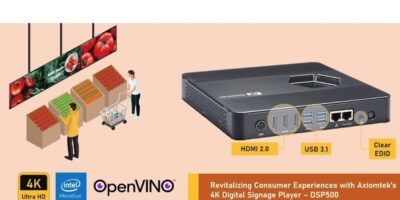For multi-display applications, such as video walls, digital menu boards, digital directory boards, and self-service kiosks, the DSP500 4K digital signage player is powered by the 9th/8th gen Intel Core i7/i5/i3 or Pentium processors.
It is also supported by the Intel Movidius Myriad X VPU and Intel Distribution of OpenVINO toolkit, says Axiomtek, to meet the diverse needs of computer vision and AI workloads. It also has the extended display identification data (EDID) function and three HDMI 2.0 ports that can support diverse content in retail areas.
The low power digital signage player is expandable via an internal M.2 interface for integrating the Intel Movidius Myriad X VPU and Intel Distribution of OpenVINO toolkit to develop a real-time promotion system. Data such as the gender and age of shoppers as well as using eye tracking can be used to analyse engagement with campaigns.
There is also support for Axiomtek’s exclusive Intelligent Remote Device Management (RDM) software, which provides a highly efficient and cost-effective solution with comprehensive remote management capabilities.
The DSP500 has two DDR4-2400 SO-DIMM slots for up to 32Gbyte of system memory. It also comes with one M.2 Key M 2280 for SATA and NVMe storage. To meet the requirement of diverse applications, the media player has four USB 3.1 ports, one Gigabit Ethernet ports, one device management port, one RS-232, one Line-out, one SIM card slot and four antenna openings.
Other features include one power switch, one remote switch, one clear EDID, and one VDC power input connector. It also has one M.2 Key E 2230 slot and one M.2 Key B for Wi-Fi, Bluetooth, or 4G LTE. The system operates over a temperature range of 0 to 45 degrees C.
The DSP500 runs on Windows 10 and Linux. It has been certified with CE and FCC Class A.







